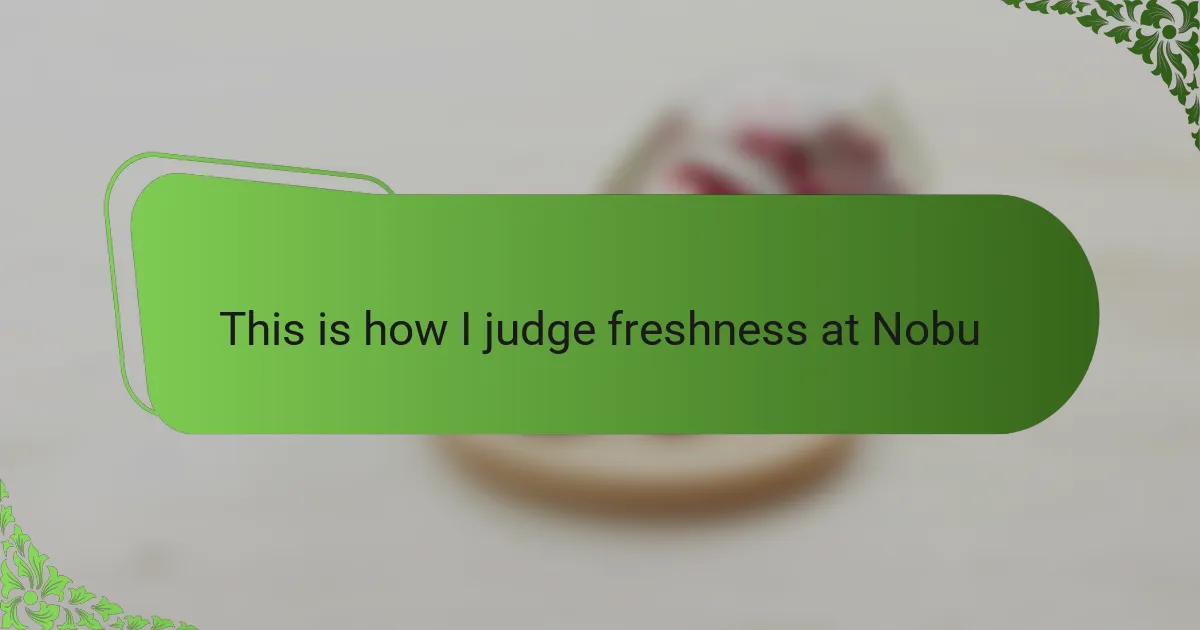Key takeaways
- Freshness in sushi is indicated by a clean aroma, firm yet tender texture, and vibrant color, which enhance overall dining experience.
- Nobu ensures ingredient quality through trusted partnerships and sustainable sourcing, maintaining high standards of freshness.
- Key indicators of fresh sushi include the texture’s responsiveness, pure ocean-like flavor, and precise cold temperature of sashimi.
- Comparative experiences highlight Nobu’s exceptional freshness standards, distinguished by aroma, texture, and visual appeal unique to their offerings.
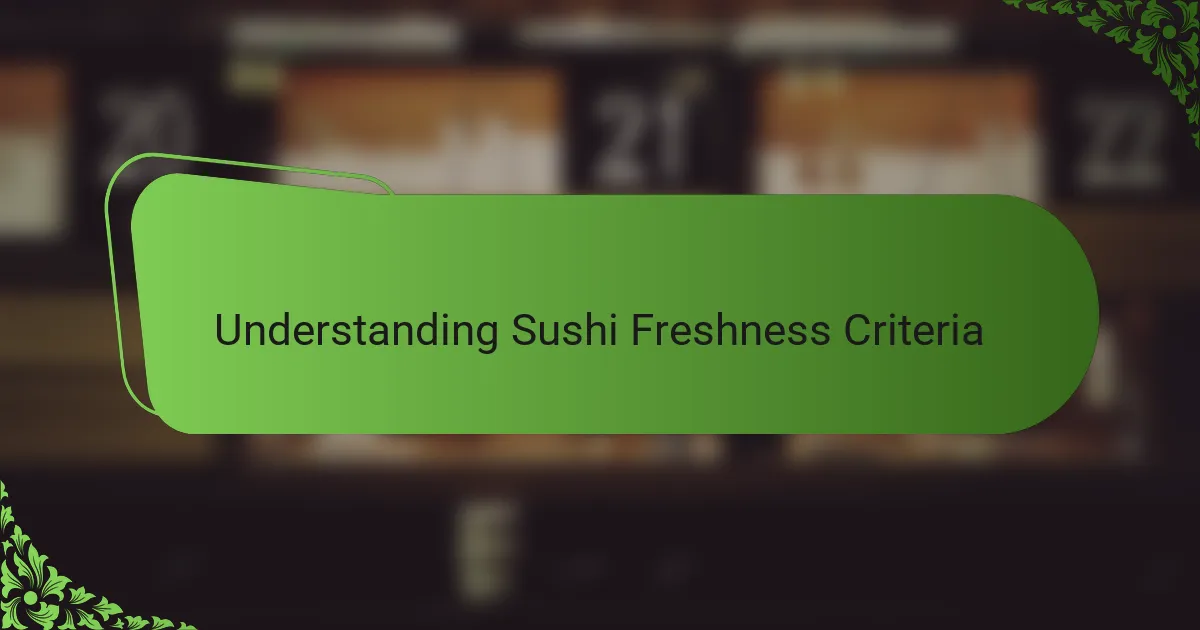
Understanding Sushi Freshness Criteria
When I judge sushi freshness at Nobu, the first clue that hits me is the aroma. Fresh fish should smell clean, almost like the ocean breeze rather than anything fishy or overpowering. Have you ever noticed how a slight off-putting smell can completely kill the anticipation of that first bite?
Texture plays an equally important role. I always pay close attention to how the fish feels against my tongue—the flesh should be firm yet tender, with just the right resistance. When the fish melts effortlessly inside my mouth, I know I’m experiencing freshness you can’t fake.
Color also speaks volumes in this context. At Nobu, the vibrant, translucent sheen of the fish signals its quality, while dull or faded colors make me hesitate. It’s almost like visual poetry that prepares your senses before you even taste a single piece.
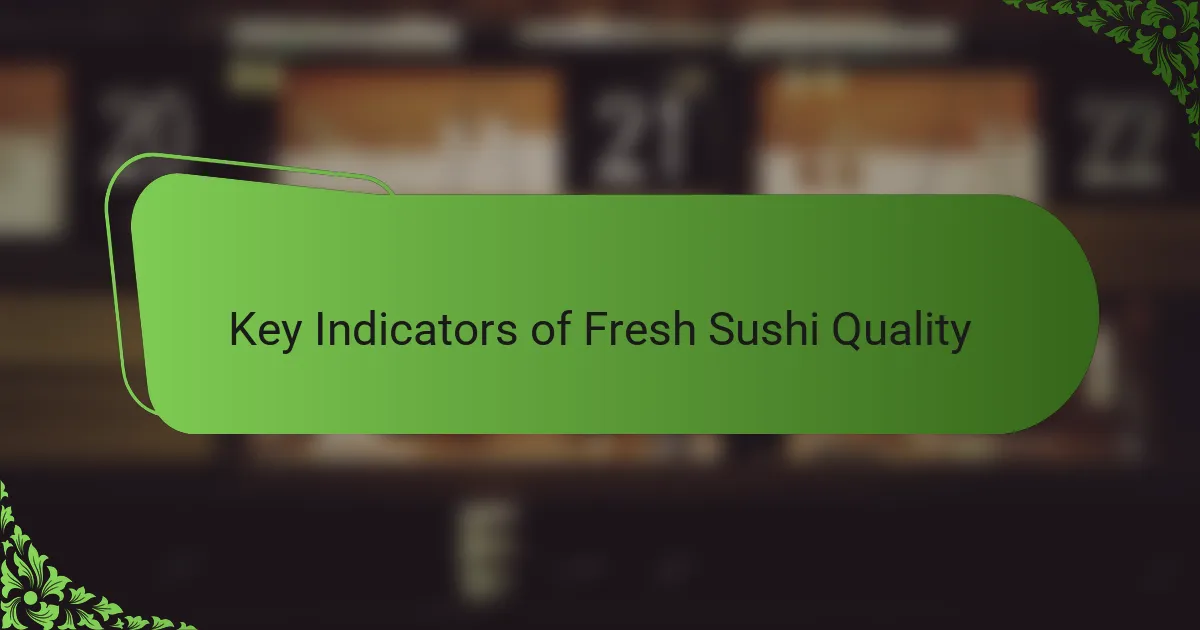
Key Indicators of Fresh Sushi Quality
One thing I’ve learned over countless visits to Nobu is that fresh sushi practically announces itself through its clean, briny scent. Have you ever caught that sharp, unpleasant fishy odor elsewhere and felt your appetite vanish? That’s a no-go in my book—freshness at Nobu means the aroma lifts you up instead of turning you away.
Then there’s the texture—the way the fish feels when it meets your tongue tells you everything. I recall one time when a piece was so perfectly firm yet delicate, it seemed to dissolve like silk. That balance between resistance and melt-in-your-mouth softness is, to me, the hallmark of superb freshness.
And the colors—oh, the colors! I can’t help but marvel when the fish gleams with a translucent vibrancy, almost glowing under Nobu’s lighting. When the hue looks dull or flat, my mind instantly questions how fresh that fish truly is. It’s like a silent, visual cue that guides my expectations before the first bite even arrives.
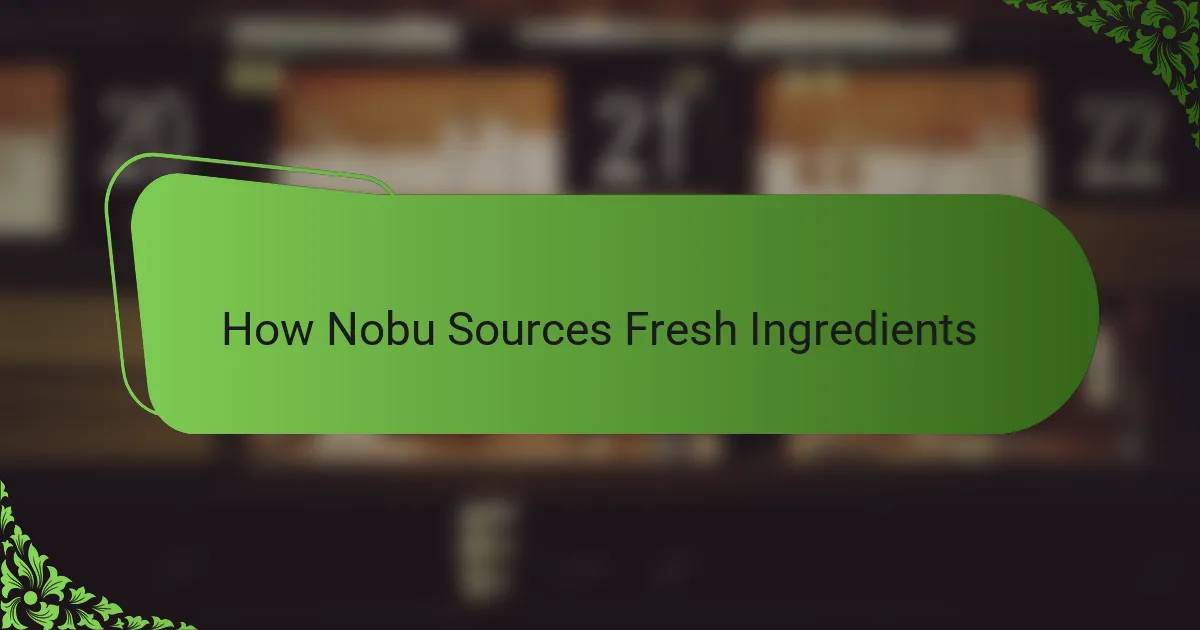
How Nobu Sources Fresh Ingredients
What really impresses me about Nobu is how meticulous they are in sourcing their ingredients. They have these trusted partnerships with fishermen and suppliers who deliver the catch daily, often straight from the coastal waters to their kitchens. I remember asking the chef once about their suppliers, and the pride in his voice told me everything—I could tell they don’t settle for anything less than the best.
I’ve always wondered how a restaurant maintains such consistent freshness every time I dine there. The answer lies in Nobu’s commitment to seasonal, sustainable sourcing. They don’t just pick any fish—they choose varieties at the peak of their season, ensuring the flavors are vibrant and the texture crisp. That thoughtful approach makes all the difference on my plate.
Another thing that stands out is how quickly the fish is handled from the moment it arrives. It’s almost like watching a well-orchestrated dance—the minute the fish reaches the kitchen, it’s being expertly inspected, cleaned, and stored under perfect conditions. That speed and precision mean the sashimi arrives at my table with all its fresh ocean essence intact. Have you ever felt the difference when fish is handled with such care? I certainly have.

Evaluating Freshness in Nobu Dishes
When I sit down at Nobu, the first bite tells me everything about freshness. There’s this unmistakable snap in the fish’s texture that makes me pause and appreciate just how carefully it’s been selected and prepared. Have you ever encountered that moment when a piece feels so alive in your mouth that it’s almost as if you’re tasting the sea itself?
I also pay close attention to how the freshness affects the dish’s overall balance. A perfectly fresh slice doesn’t overpower the accompanying rice or seasoning—it harmonizes and elevates them. Once, I noticed that a less fresh bite made the flavors clash, and it was clear that something subtle had been lost somewhere along the supply chain.
Finally, freshness at Nobu often reveals itself in the subtle coldness of the sashimi when it reaches the table. It’s not just about being chilled, but that delicate coolness that preserves the natural flavor without dulling it. That precise temperature difference, I’ve learned, is a clever trick chefs use to lock in the fish’s vibrant character until the very first bite.
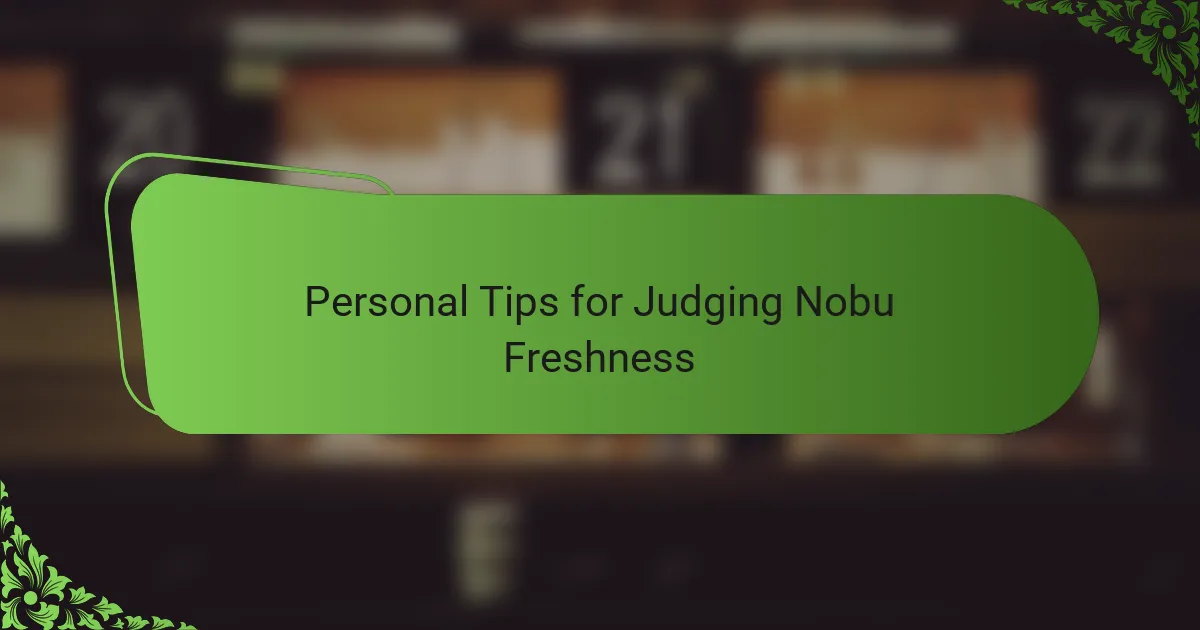
Personal Tips for Judging Nobu Freshness
One trick I use to gauge freshness at Nobu is observing how the fish responds when I gently press it with my chopsticks. Does it bounce back quickly or feel limp? That subtle resilience tells me a lot about how recently it was caught. Have you ever noticed how a fresh piece seems almost alive, almost eager to be tasted?
Another tip I rely on is trusting my palate the moment the sushi touches my tongue. Is there a clean, pure flavor that instantly transports me to the ocean’s edge? If the taste lingers with any hint of bitterness or dullness, I know my freshness radar needs recalibrating. That immediate impression has saved me from disappointment more times than I can count.
Finally, I never underestimate the value of watching the chefs in action. The way they handle the fish—swift yet gentle—gives me confidence that freshness isn’t just a word here, it’s a practice. Have you ever felt reassured simply by witnessing someone’s careful craftsmanship? At Nobu, that moment always seals the deal for me.
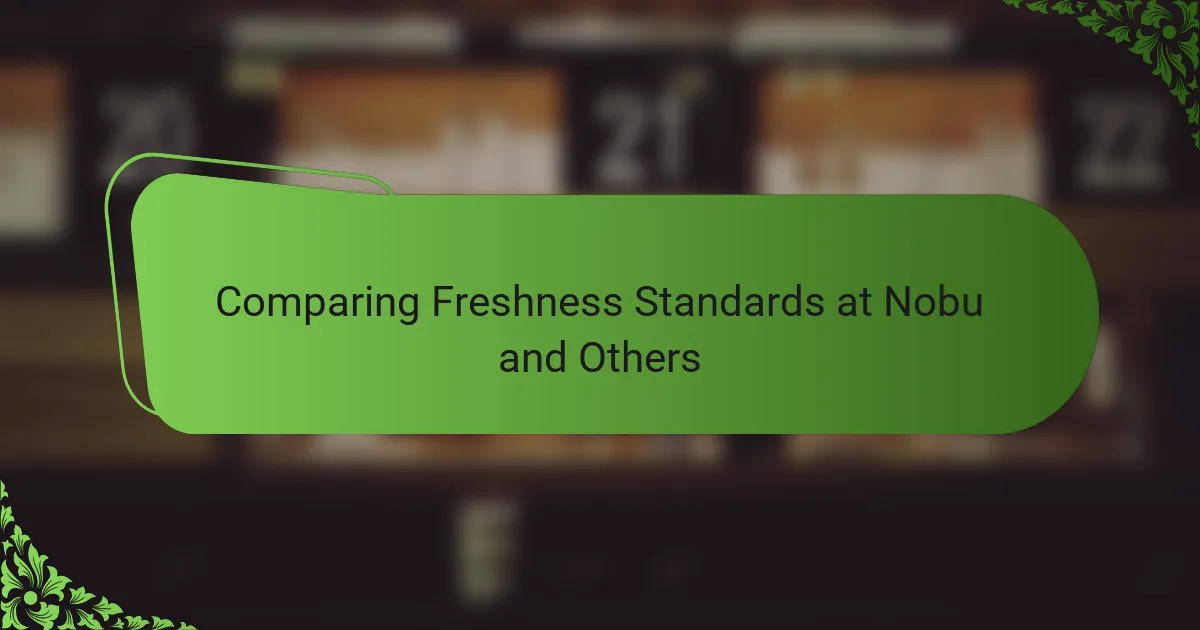
Comparing Freshness Standards at Nobu and Others
When I compare Nobu’s freshness standards to other sushi spots, the difference is instantly clear. I remember visiting a few local places where, despite good reviews, the aroma didn’t enthrall me like Nobu’s does—it was sometimes faintly off or dull. That subtle but unmistakable freshness Nobu delivers feels like a signature you just don’t get everywhere.
Texture is another area where Nobu stands out. On several occasions at other restaurants, I noticed fish that was either too soft or rubbery, lacking that perfect balance between firmness and melt-in-your-mouth tenderness. At Nobu, every bite feels carefully calibrated; it’s like their fish is alive with freshness rather than just passably good.
Color, too, tells its story. I’ve often caught myself hesitating over the sashimi’s hue elsewhere—dull, lackluster shades that never inspire confidence. Compare that to the vibrant, almost glowing cuts Nobu serves, and you realize how much care goes into selecting and presenting every piece. It’s not just sushi; it’s a visual promise of quality that sets Nobu apart in the crowded sushi scene.
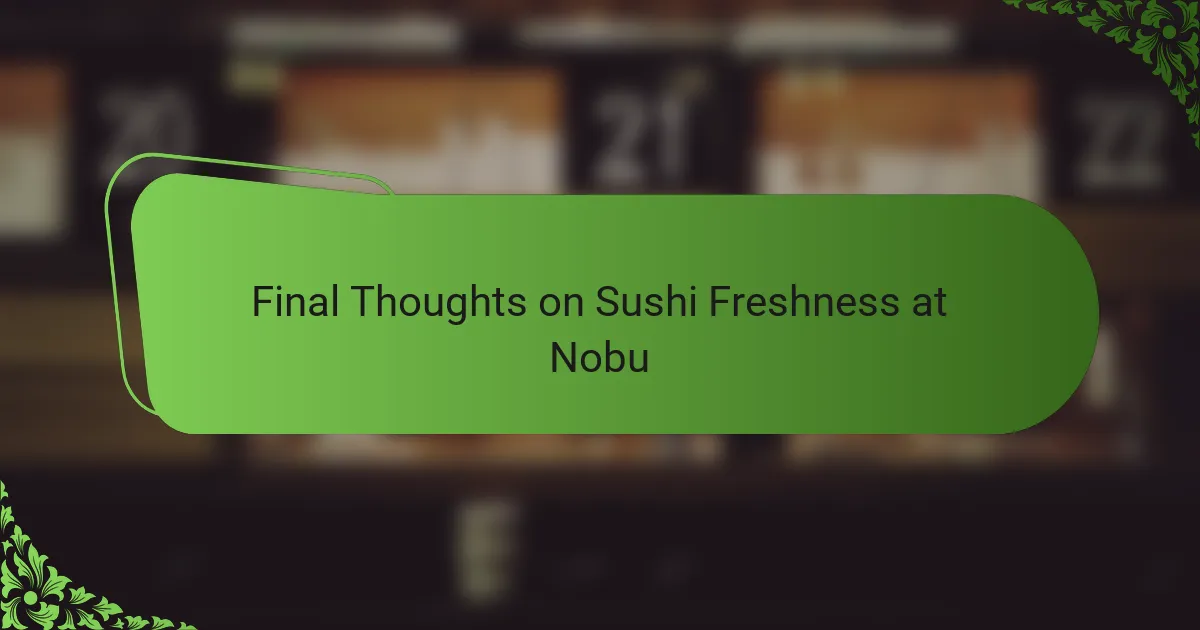
Final Thoughts on Sushi Freshness at Nobu
When I think back on the sushi freshness at Nobu, what sticks with me most is that consistent sense of reassurance every time the first piece touches my tongue. Have you ever had a meal where you just knew, without a doubt, that every ingredient was handled with care? That’s exactly the experience Nobu delivers, and it’s a feeling I value deeply.
What truly impresses me is how those key freshness cues—the clean aroma, the perfect texture, the vibrant color—come together seamlessly. It’s not just about one element shining; it’s the harmony of all these details that makes me confident the sushi is at its peak. I often find myself savoring each bite a little longer, just to appreciate that level of quality.
In the end, judging freshness at Nobu has become almost instinctual for me. When I notice even the tiniest deviation, it pulls me out of the moment. But that rarely happens here—Nobu has earned my trust through repeated, fresh, flawless experiences, and that trust is what keeps me coming back.
